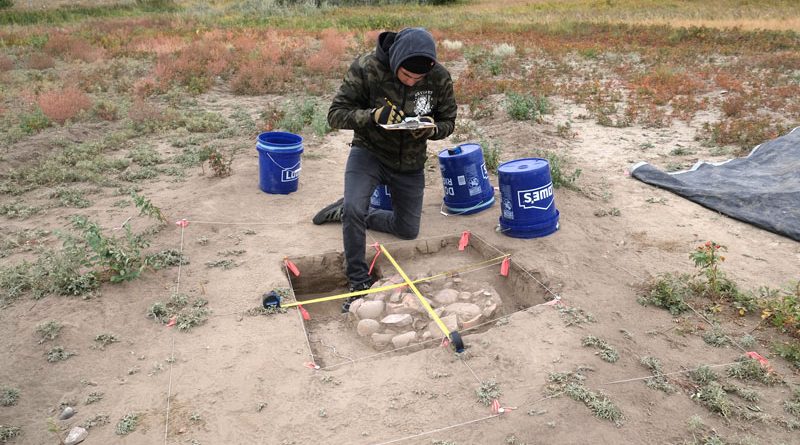Archeology and culture combined at Siksika Nation field program
By Sean Feagan, Local Journalism Initiative Reporter

Photo Courtesy of Lindsay Amundsen-Meyer
An archeology program held this fall in Siksika Nation blended research techniques with cultural knowledge to create a unique learning experience for students.
The pilot archaeological training program was led by Lindsay Amundsen-Meyer, an archeology professor at the University of Calgary, and Leon Crane Bear, a member of Siksika Chief and Council, in partnership with Old Sun Community College at Siksika. The course was funded by TC Energy.
Increasingly, many First Nations are looking to manage historical resources internally, but often lack the capacity and expertise to do so, explained Amundsen-Meyer. In 2018, an area on Siksika Nation was stripped (topsoils removed) for an ongoing development and a grouping of artifacts were uncovered, paving the way for the program.
After the artifacts were discovered there, Siksika Nation was interested in gaining data on the impacts of the development and the archeological material there, so archeologists were requested to visit the site, first from Stantec, then later from the University of Calgary.
Seeing an opportunity, the University of Calgary archeology department, which was already considering providing a heritage program for Old Sun students, started to develop a field program that would ultimately use the site as a learning ground for Siksika students.
“It kind of fell into place that the program was a possibility,” said Amundsen-Meyer.
The program provided a post-secondary archeology program at a real-world training ground to practice modern research approaches, including mapping, survey strategies, excavation and artifact analysis.
But the course did not feature archeology only.
Crane Bear, who has a master’s degree from the University of Lethbridge and studies federal policy in relation to Indigenous people, helped connect the archeological approaches taught in the program to the Siksika cultural experience, including its oral history. This included a teepee raising, a kick-off ceremony, and visits from elders to the site.
In effect, the course helped the students to make connections between their own cultural past, their cultural knowledge and the archeological record, said Amundsen-Meyer. “That’s a real power that archeology has – to have these tangible objects that we can see and hold to make those connections.”
These experiences gave the students a sense of belonging, said Crane Bear, who marked the journal of each student describing their experiences.
“They were all positive comments and it’s a sense of belonging that they talked about,” he said. “For a lot of them, it was discovering something new and relevant to them and their identity.”
While the course approach helped the students gain new perspectives, it clears a new path forward for the discipline, said Amundsen-Meyer.
“Archeology has been colonial and, to a large degree, still is in many contexts – we are often settler archeologists doing archeology on Indigenous land,” she said. “But aside from that, in the slightly more distant past, it has been specifically used as a tool of colonialism to subjugate Indigenous people in a lot of ways.
“That is a past of our discipline that we have to deal with.”
